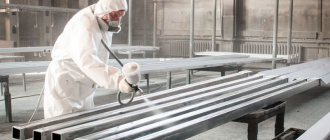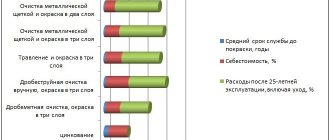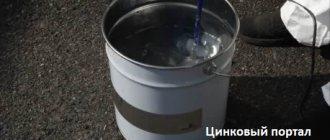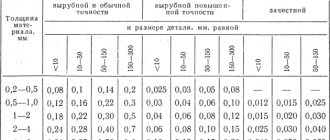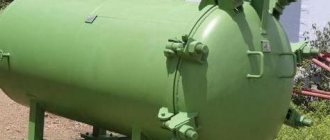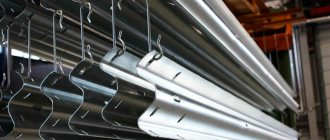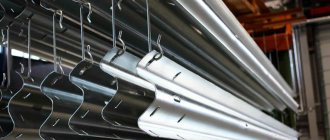It is important for metal to be protected from corrosion, which causes enormous losses throughout the world. Indeed, according to research, at least ten percent of the metal becomes unusable precisely because of it. Many ways have been developed to prevent such a destructive process. Most of them come down to blocking access of the oxidizing environment to the metal surface. Thermal diffusion galvanizing is just one of these methods.
The thermal diffusion process of applying a zinc shell is also notable for the fact that it makes it possible to slow down the so-called electrochemical corrosion. This is due to the structure of the metal zinc, which has a more negative potential than steel. Therefore, first of all, it is destroyed, localizing and stopping all sources of corrosion at any point in the coating.
Story
Before the innovative developments of engineer Sherard, steel protection with zinc was also used, but the protective coating was applied using the galvanic method, which had a lot of disadvantages:
- “Hydrogen embrittlement” of steel when zinc is applied to it by electroplating. High-strength steels, as well as titanium and nickel alloys, suffer the most from this process. Its essence is the recombination of atomic hydrogen into molecular hydrogen, which, remaining in nanopores, can then expand or contract under the influence of temperature changes, which over time causes microcracks.
- Unevenness of the protective layer on the metal.
- The impossibility of galvanic application of zinc to parts of complex shape.
- Low durability of zinc galvanic coatings (no more than 140 hours in aggressive environments).
Thermal diffusion galvanizing appeared in the first decades of the twentieth century not by chance: it was by this time that the level of technological development allowed the leader in this matter, England, to create autoclave containers for the process of hot anodic introduction of zinc into pipes and rolled products.
This is interesting: Hot galvanizing of metal: technology, equipment, GOST
Description of the technological process and equipment
The essence of thermal diffusion galvanizing technology is the formation on the surface of a metal product of a new alloy or intermetallic compound of a complex phase structure with a high zinc content. The parts and the zinc-saturated mixture “Termishin” (hereinafter referred to as Termishin powder) are loaded into a special container (retort), which is then placed in a special muffle furnace.
Next, uniform, timed heating of the container with parts and Termishin© powder is ensured.
Thermal diffusion
The essence of the chemical process of thermal diffusion is expressed in the fact that the property of negative values of the redox potentials of the Zn2+/Zn pair is used. That is, zinc in this type of coating protects the steel electrochemically, anodically, that is, in the event of exposure to aggressive and simply unfavorable environments for iron in the steel, the zinc first “suffers.” But this process is slow, and the steel will have time to serve for a very long time, which will depend on the depth of penetration of zinc atoms into the crystalline structure of steel or other metals subjected to thermal diffusion galvanization. Chemically, this looks like the formation on the surfaces of metal products of a so-called intermetallic compound with a complex phase structure with a large percentage of metallic zinc.
Technologically, the process of coating metals with zinc and its thermal diffusion was carried out in a hermetically sealed container, maintaining a constant temperature of about 300-450⁰C. This temperature variation depends on the grade of steel being coated with zinc, the type and configuration of steel products, as well as on the requirements for galvanizing by customers. Suffice it to say that during the years of England's monopoly production of galvanized products, the income received by the metallurgical industry amounted to amounts that helped the industry survive the global economic crisis that broke out at the end of the 20s.
The technology of thermal diffusion coating with zinc made it possible to regulate the depth of diffuse penetration of the protective zinc layer into the metal using a predetermined temperature and time during the process. This layer is formed by powder from a zinc-saturated mixture. The parts to be coated with zinc and this mixture are loaded into a specially shaped heat-resistant container, and it is already placed in a large muffle furnace.
Thermal diffusion galvanizing of metal: pros and cons
The undeniable advantages of the technology include:
- excellent adhesion of the zinc layer to the metal surface;
- compared to hot galvanizing - compact equipment, the ability to work in small areas;
- low labor costs, and therefore cost-effective;
- coating durability;
- evenness of the layer, the ability to adjust its thickness during application;
- harmlessness to personnel and the environment;
- almost complete zero waste - the products remaining after processing are easily disposed of;
- simplicity and energy intensity of technology.
However, thermal diffusion galvanizing of metal also has disadvantages.
Products galvanized in this way lose in aesthetics: they have a dull grayish tint. The problem can be solved by applying a decorative coating over galvanization. Although for purely technical parts, the “mouse” color is not of fundamental importance. A much bigger disadvantage is that the possibilities of galvanizing parts directly depend on the size of the chamber. And it is usually very compact. Therefore, this technology is not suitable for protecting large-sized rolled products.
Formation of thermal diffusion coating
During the coating formation process, the container with the parts is constantly in the process of rotation, which ensures good and uniform mixing of the parts with the saturating mixture and subsequent uniformity of the coating over the entire surface of each part.
After the process is completed, the galvanized parts pass through a passivation solution.
Fundamentally new in Termishin galvanizing technology is:
- Termishin© powder: has high penetrating ability due to the presence of special additives;
- provides a controlled coating formation process;
- allows you to work in the thickness range of 6-9 microns with high corrosion resistance.
- do not contain Cr VI and other harmful substances;
Thermal diffusion coating technology
The coating process is a closed technological cycle, divided into several operations.
- preliminary cleaning of parts from grease, rust and scale;
- galvanizing of parts;
- application of protective passivation layers and/or application of other finishing layers (painting, gumming, plasticization, etc.);
- drying of finished products.
In the process, there are also intermediate operations for loading/unloading parts, washing, etc.
Note! To obtain a high-quality anti-corrosion coating, all technological stages are equally important and are equal components of the technological process.
The coating technology does not change for any type of part.
The features of each stage are different surface preparation for different types of parts.
Galvanizing technology provides:
- shot blasting of parts;
- ultrasonic surface preparation.
Cold-rolled steel parts are loaded into the container without pre-treatment. Parts in oil or coolant require preliminary degreasing.
Coating stage
- It lasts 90 minutes. or 180 min. (depending on the installed equipment and types of galvanizing mixtures used).
- Part of the time is spent on heating the parts and the saturating mixture to the required temperature and then, when the specified temperature parameters are reached, the galvanizing process occurs directly.
- After which the container is removed from the oven and cooled.
Galvanizing occurs at temperatures from 290C to 400C. The choice of temperature regime depends on the type of steel products, steel grade and the installation standards of the parts manufacturers.
Throughout the entire galvanizing process, the container is in a rotating state and stops only before the container is directly removed from the furnace.
The thickness of the zinc layer on the surface can vary from 5 to 100 microns.
It is regulated only by the amount of saturating mixture, which is placed in the container along with the parts.
The processing time is constant, which is very convenient for planning production activities. After cooling, the container is unloaded and the product enters the finishing operations stage.
Passivation stage
Passivation solutions (for the first and second passivation) are the know-how of the manufacturer.
These solutions operate at room temperatures, in a closed cycle with constant regeneration of solutions.
Initially prepared passivation solutions during operation require only the necessary technical support and are not associated with the sewage system.
Passivation solutions do not require overflow or drainage during the process, are simple and do not contain any aggressive or harmful components.
This is interesting: KGShP (crank hot stamping press): characteristics and features
Features of thermal diffusion galvanizing of metal products in an electromagnetic field (TDCE)
One of the most common methods of protecting metal products from corrosion is galvanizing them.
This is explained by the fact that zinc has a stationary potential, 0.2-0.3 mV more negative than that of iron. When exposed to electrolytes contained in aggressive environments, marine or industrial-urban atmospheres, as well as in moisture-saturated concrete, the zinc coating slowly dissolves due to electrochemical reactions, thereby protecting the ferrite substrate. Thus, the zinc coating acts as a protector, “smeared” over the surface of the protected steel structure. Zinc coatings are relatively inexpensive and provide long-term anti-corrosion protection to the steel substrate. The most widespread in the practice of protecting metal products from corrosion are the following galvanizing methods: galvanic, “hot” from molten zinc, gas-thermal spray galvanizing, “cold” by painting metal products with zinc-filled paints, thermal diffusion galvanizing. Let's consider the advantages and disadvantages of these methods.
Galvanic galvanizing, due to the production of too thin coatings and the formation of the coating in special low-capacity baths, is unacceptable for the protection of large-sized metal structures. The preparation of a steel surface for galvanic galvanizing is carried out by the environmentally hazardous method of chemical etching in acids, which can increase the risk of hydrogenation of the metal, which contributes to the unpredictable brittle destruction of critical metal structures operating in a complex state.
The hot-dip galvanizing method involves dipping pre-cleaned metal products by chemical means (by acid etching) into a bath of molten zinc-aluminum alloy at a temperature of 460-480 oC and holding for 10-15 minutes.
Advantages of hot-dip galvanizing
- Comparative simplicity, low cost and manufacturability of galvanizing operations;
- Relatively high protective ability and durability, determined by the selected coating thickness from 30 to 300 microns at a rate of corrosive wear of the coating equal to 2-3 microns per year in a moderately cold climate in non-aggressive environments;
- Hot zinc coating, in principle, cannot be subsequently painted, with the exception of surfaces that require decorative painting.
Disadvantages of hot-dip galvanizing
- The complexity and environmental hazard of preparing the surface for etching coating, as well as the risk of new growth;
- The need to constantly maintain the temperature of the zinc melt around the clock, which requires significant energy consumption;
- Uneven thickness of the coating on the galvanized surface, formation of sagging (when removing structures from a bath with a viscous melt) on the lower edges and in the holes, which requires subsequent expensive work to clean the zinc coating in places where the mounting surfaces are adjacent;
- Relatively low adhesive bond with the substrate;
- Significant technological losses of expensive zinc, manifested in the formation of a zinc-iron compound in the molten bath (the so-called hardzinc, up to 1/3 of the amount of zinc consumed);
- Existing hot-dip galvanizing baths make it possible to galvanize metal structures up to 11 m long; they are usually used for galvanizing building products in the form of railings, road fences, electric lights, lightning rods and similar structures;
- High initial cost of organizing a hot-dip galvanizing site, reaching 10 million US dollars;
- In many regions of Russia (Siberia, the Far East) there are no hot-dip galvanizing areas at all;
- The need for additional surface or its artificial aging for painting, which also increases the cost of production.
Gas thermal and thermal diffusion galvanizing
During gas-thermal galvanizing, spraying is applied to structures, elements and their parts, the shape of the surface of which allows a stream of sprayed metal to be directed at it at an angle of 90-45 degrees. The method is suitable for coating products of any size and is mobile. The cost of applying such coatings is 3-4 times more expensive than galvanizing using other methods; as a result of gas-thermal galvanizing, uneven thickness of the coating on the galvanized surface is obtained; it is difficult to control the work and obtain a coating that complies with regulatory documents; narrow gaps (< 20 mm) and deep holes (depth > 50 mm), pockets and other places inaccessible for spraying are unacceptable (according to GOST 28302-89), measures must be taken to prevent deformation of structures and products.
In recent years, the traditional method of producing thermal diffusion coatings (TDC) has been improved and the disadvantages of the method have been eliminated by replacing radiation heating of retorts with galvanized parts with induction heating. In the proposed method of thermal diffusion galvanizing in an electromagnetic field - TDCE (patent for invention No. 2424351 “Method of applying zinc coating and installation for its implementation”), the retort is placed inside a chamber with an inductor. Due to the fact that the charge located inside the retort is a paramagnetic and finely dispersed material, it is practically transparent to electromagnetic waves generated by the inductor; therefore, the charge is heated due to convective heat transfer from the retort body and the galvanized products. Unlike the charge, galvanized metal products are ferromagnetic. As a result, eddy currents arise in products placed in the magnetic field of the inductor, which heat the products to temperatures of 500-800 °C inside the retort volume. The process of thermochemical diffusion is reduced tens of times, since the parts are heated in 25-30 minutes, depending on the amount of supplied electrical power, the magnetic properties and thickness of the retort material, as well as the mass of the processed products.
The structure of the coating practically consists of α- and δ-phases; the interlayer of the G-phase, which reduces the quality of the coating, is negligible. The zinc content in the top layer of the coating with a thickness of 60 microns reaches 98%.
The required coating thickness is regulated by the heating time, the specified galvanizing temperature, the characteristics of the range of metal products loaded into the retort, and the composition of the charge.
Let us consider another important feature of the proposed method of thermal diffusion galvanizing. The use of induction heating allows, in contrast to the method of traditional thermal diffusion with radiation heating, to form a homogeneous zinc layer of the required thickness due to induction currents and heat coming from inside the galvanized part, complete remelting of the old and subsequent layers of zinc occurs. Thus, the use of induction heating allows, unlike other galvanizing methods, to restore the zinc coating if its thickness is insufficient or if it is damaged.
Summarizing all of the above, the advantages of the thermal diffusion galvanizing method in an electromagnetic field (TDZE) include the following:
- Parts are galvanized in hermetically sealed retorts, so the diffusion galvanizing process is environmentally friendly and does not require the creation of treatment facilities;
- The resulting coating has no porosity due to the diffusion layer and has a strong adhesive bond with the substrate, because the coating is a multilayer set of intermetallic compounds, including those that have penetrated into the body of the substrate, which is very important when protecting metal products used in “severe” conditions, for example in ice conditions, temperature changes;
- The method allows for hardening of products and repair work to restore the surface layer of products;
- The protective ability of the coating is many times higher than that of galvanic coatings, and higher than that of coatings formed by hot-dip galvanizing;
- The thickness of the coating can be any (according to the customer’s technical specifications) and depends on the exposure time of the galvanized parts in the oven and the mixture recipe used;
- Diffusion zinc coats parts with a uniform layer without beads, accurately repeating the profile of the galvanized surface, providing uniform thickness with an accuracy of profile reproduction from 10 to 300 microns, in any required layer, in any required area without beads, including elements of complex configuration, threaded connections (when covering data products from 10 to 30 microns), the possibility of selective coating of areas, including blind holes, elements of complex configuration, cracks, cavities, threads, etc.;
- The method allows, unlike others, to galvanize long pipes on both sides, and, if necessary, coat only the inner or only the outer surface of the pipes, depending on the placement of zinc-containing powder mixtures - outside or inside the pipes;
- Production waste does not require burial and can be used as fillers for construction concrete mixtures;
- Diffusion zinc coating is approved for contact with drinking and domestic water supply by State Sanitary and Epidemiological Supervision Certificate No. 78.1.3.315.P.17512.9.99 dated 09/06/1999.
We note in particular detail the role of the method and the need to use the TDCE method (based on what was previously stated) in areas where reinforced concrete structures are used (ice-resistant offshore platforms, hydraulic structures, etc.). Reinforced concrete structures, despite their high strength indicators, are prone to destruction during operation. This is explained by the fact that concrete has a fairly porous structure that actively absorbs moisture. And although concrete becomes stronger when saturated, at subzero temperatures the water that has penetrated into the concrete, freezing and expanding, forms cracks in the monolithic structure.
The increased content of carbon dioxide in the atmosphere in recent years also leads to carbonization of concrete. The lime (calcium hydroxide) contained in the material is converted into calcium carbonate, the pH value decreases, i.e. The acidity of the environment inside the concrete increases, due to which intense corrosion of the surface of steel structures in contact with concrete begins. Also, porosity and the appearance and appearance of cracks in concrete facilitate the flow of moisture, air and aggressive substances from the environment to the surface of the reinforcement, as a result of which its passive state at the locations of the cracks is disrupted, as a result of a violation of its passivity caused by a decrease in alkalinity to pH < 12, steel corrosion, the adhesion of reinforcement to concrete decreases. Rust, which forms during the oxidation of steel, having a volume 14 times greater than monolithic metal, increases the internal pressure in concrete and leads to concrete fractures and exposure of steel structures. The exposed metal corrodes even more quickly, contributing to further destruction of the concrete. The carbonization rate can reach from 1 to 6 mm per year.
Chlorides contained in the marine atmosphere and in anti-icing agents also contribute to the deterioration of concrete and steel reinforcement. Since carbonization processes, as well as the effects of chlorides and sulfates, are inevitable, it seems advisable to apply protective coatings to prevent destruction of steel, monolithic steel bridge structures.
In accordance with the recommendations of GOST 31384-2008 (Appendices E and I) and SNiP 2.03.11-85, concreted steel structures must be protected from corrosion. It is recommended to metalize steel building parts before laying them in concrete by hot-melt galvanizing, thermal spraying, thermal diffusion galvanizing, as well as the “cold galvanizing” method with zinc-rich paints. The thickness of the zinc coating must be at least 100-120 microns to eliminate porosity of the metal layer and reduce the intensity of zinc dissolution. Since metallization by spraying on the surface of embedded reinforcement seems to be very labor-intensive, the most technologically advanced method of galvanizing it can be thermal diffusion galvanizing (TDG) in special retorts that allow galvanizing long products up to 12 m long. The TDT method can be improved by heating the galvanized products using the electroinductive method (TDCE), which intensifies and accelerates the galvanizing process by an order of magnitude and improves the quality of the processed product.
TDCE technology and coating comply with regulatory documents:
- GOST R 9.316-2006 “Thermal diffusion zinc coatings. General requirements and control methods;
- GOST R 51163-98 “Thermal diffusion zinc coatings for fasteners and other small products”;
- RD “Zinc coatings for steel products of marine equipment. Technological process of applying zinc coatings by thermal diffusion in an electromagnetic field" GKLI 3240-0392012;
- RD “Zinc protective coatings for steel pipes of ship systems. Technical requirements. Typical technological process." RD 5.95027-88;
- STO 02494680-0034-2004 “Protective thermal diffusion zinc coatings on elements of metal structures and fasteners. General technical conditions" Standard of the organization of the Central Research Institute PSK named after. Melnikova.
Currently, a new innovative method has been developed (Patent for invention No. 2424351) for applying thermal diffusion zinc coatings (and other coatings), an installation has been created as a result of the implementation of the state program for the development of the civil fleet of the R&D “Thermodiffusion”, and the tests for corrosion resistance and mechanical strength and resistance to abrasive wear. The installation allows for thermal diffusion galvanizing in an electromagnetic field of long metal structures with a productivity of up to 20 t/hour (depending on the design features of the products).
This installation is capable of solving problems of corrosion protection of metal structures at an industrial level. This significantly expands the possibilities and boundaries of using an innovative method - thermal diffusion galvanizing in an electromagnetic field (TDZE) of metal products.
Comparative analysis of the characteristics of zinc protective coatings
| Characteristics of zinc coatings | Hot galvanizing | TDC | TDCE |
| Phase composition | |||
| α phase | Fe21Zn | Fe21Zn | Fe21Zn |
| γ phase | Fe3Zn10 | Fe3Zn10 | Fe3Zn10 |
| σ phase | FeZn11 | FeZn12 | FeZn7 |
| ζ phase | FeZn13 | ||
| η-phase | Zn, ZnO | ZnO | |
| Surface layer density, g/cm3 | 7,13 | 7,22 | 7,25 |
| Microhardness of the surface layer, MPa | 350 | 3470 | 3830 |
| Average rate of change in the specific gravity of the sample, g/(cm2/h) | -7,5·10-7 | -5·10-7 | -4·10-7 |
Photo: Thermal diffusion galvanizing installation
Based on materials from the magazine “Paints and varnishes and their application”
Scope of use
This processing method creates a uniform layer even in hard-to-reach places. Micron layer thickness allows processing of small parts. Thermal diffusion galvanizing is subjected to:
fittings for the oil, gas, construction and railway industries;- fencing of bridges and roads;
- hardware;
- furniture fittings;
- fitting;
- power line structures;
- car elements.
Zinc composition – Termishin
In Russia, metallurgy during thermal diffusion galvanizing uses a zinc composition developed - Termishin©, with special additives that ensure an even and stable diffusion coating of the metal with zinc powder.
After closing the product and powder with additives in the container, rotation of the unit is also ensured, which is achieved by a complex drive system. During this rotation, constant mixing of parts and additives occurs, which ensures uniformity and uniformity of the zinc coating. After annealing, the products are further processed in baths with a passivation solution.
Termishin© zinc powder mixtures allow:
- apply a thermal diffusion coating on products and parts with a thickness of 5 to 10 microns;
- do not use harmful substances traditional for this technology;
- give the coating additional anti-corrosion resistance;
- provide a marketable appearance, giving the surface of the products a “frosty” pattern.
How does the processing process work?
The modern process of obtaining zinc coating using the thermal diffusion method has undergone some changes and improvements and includes the following steps:
- Treatment of products at the preliminary stage by chemical, mechanical or ultrasonic action.
- Placing pre-treated parts in a special work box, where zinc-containing powder is also added.
- Sealing the box and creating the required elevated operating temperature inside it.
- Holding products for a certain time, removing them from the chamber and carrying out additional processing measures.
The process will be more intense if such a chamber is subjected to rotation.
The first stage is necessary in order to get rid of shells, peelings, cracks, rust and grease films that can form on the surface of the product and prevent the deposition of zinc. This can be dealt with effectively by subjecting the parts to treatment with abrasive materials in sandblasting-type installations, followed by degreasing with chemical liquids and ultrasonic cleaning, although the diffusion process is less demanding on surface cleanliness than, for example, galvanic.
The box, or chamber for thermal diffusion galvanizing, is a stainless steel structure with a tightly closing lid. By placing the workpiece and zinc powder there, the temperature inside is maintained at about 450 °C for 1-4 hours, it all depends on how much coverage is required and how thick the zinc layer should be formed. During this time, zinc molecules will evaporate and penetrate into the crystal lattice of the metal.
When thermal diffusion galvanizing is completed, the workpieces are removed from the chamber and subjected to a series of cleanings. The first thing that is removed is the remaining powder particles, then the products are washed and at the last stage passivation is carried out - improving the appearance of the products, giving them a decorative presentation.
Application area
Most often the technology is used on such products as:
- fittings used in the gas production and oil refining industries;
- Walling;
- pipeline elements, fittings for construction;
- various parts of furniture fittings;
- fittings for the production of road surfaces;
- car elements;
- power line details;
- most hardware.
Purpose and application
During the process of thermal diffusion galvanizing, a coating appears on the part, the basis of which is a Zn-Fe alloy. When heated, due to diffusion, zinc molecules penetrate into the surface layer of the metal product, which ensures reliable adhesion (cohesion) of metals.
The coating has a high degree of resistance to mechanical stress and can withstand dynamic loads and impacts. Not subject to chipping or peeling when parts are deformed. Possessing excellent anti-corrosion properties, products subjected to thermal diffusion galvanizing can successfully function in aggressive environments for decades.
Thermal diffusion galvanizing is used for coating products in the oil and gas industry, for processing components and parts of personal and public transport, elements of railway equipment, and parts of power transmission lines. Widely used in the creation of fasteners, furniture fittings, fittings, and enclosing structures. The technology makes it possible to obtain a thin (from 5 microns) but durable coating, therefore it is suitable for processing small-sized products, and is suitable for application to parts of complex shapes, including those with internal cavities.
Production Features
Thermal diffusion galvanizing is also called sherardization (in honor of the scientist who discovered this process). To impart the above properties to the metal, special equipment is required. It allows you to work with high temperatures and active mixtures.
Thermal diffusion galvanizing occurs in accordance with GOST R9.316-2006. It is based on the physical phenomenon of diffusion of alloying constituents of metals passing into the upper layers of the product. This process requires very high temperatures - 400 - 470 degrees. The choice of temperature regime depends on the type of steel, the future purpose of the workpiece and the requirements of the manufacturer.
With this mechanism of action, a uniform protective layer is formed on the parts. And this applies not only to the surface, but also to more inaccessible places, as a result of which 30% of the entire product becomes processed. Thanks to this, a part is obtained without flaws. Although there are experts who note that exposure to high temperatures leads to the fact that the product does not receive proper anti-corrosion protection and easily delaminates.
Diffusion galvanizing helps create precise coating thickness. But this only happens if certain conditions are met.
- Firstly, high-quality cleaning. All dirt is removed from the surface and degreased.
- Secondly, galvanizing takes place only in an inert or reducing atmosphere. This is what is created in the container. Also, the chamber must be sealed, since oxygen does not allow proper diffusion to occur. During processing, special activators are added.
To create a zinc coating, the product is driven through the required steps:
- cleaning from dirt - shot blasting, ultrasonic or sandblasting methods can be used;
- placing the product and saturating composition in equipment that will constantly rotate;
- coating with a zinc layer.
As soon as the element goes through all the processes, it is removed from the container and cleaned of any remaining mixture. At the end, passivation is carried out, which avoids the appearance of yellow and white corrosion products in subsequent operation. Before using the finished part, it is given time to cool.
Such processing is only possible in factory production conditions, as it requires certain conditions. And this is not to mention the fact that the cost of equipment for diffusion galvanizing is quite high.
Video:
Advantages and disadvantages
Thanks to modern technologies, many options for protecting metal structures have been developed. Therefore, it would be a good idea to familiarize yourself with the arguments why diffusion galvanizing is more profitable or worse than other technologies.
Among the advantages, the following points are noted:
- processing conditions provide high adhesion;
- efficiency of work, since the working area is not large and a minimum of effort and energy is required to carry out galvanizing;
- the finished coating has a perfectly flat surface and is highly resistant to corrosion;
- diffusion takes place in a sealed container, which means there is no toxic, chemical or environmental hazard;
- without changing production technology, it is possible to obtain a coating thickness from 6 to 100 microns;
- Processing one part takes 2-4 hours;
- if the required coating thickness is maintained, the product becomes more resistant to corrosion;
- the original shape of the element is preserved;
- production waste does not require specific disposal;
- final cleaning occurs without the use of chemical compounds and acids;
- after processing, the strength characteristics increase, making them more resistant to abrasive influences;
- Although the equipment is expensive, it has a very simple design.
The list of advantages is quite impressive.
But every barrel of honey has its own fly in the ointment. And galvanizing was no exception. Among the disadvantages are the following points:
- the appearance of the processed part is unattractive - a gray layer appears;
- The container has limited dimensions, so the part must be of appropriate dimensions.
But judging objectively, these are not such big disadvantages. Rather, the features of the process.
Video:
Main points of GOST R 9.316-2006
Gosstandart was developed to control production quality and safe operation. This applies to all things, including zinc coating.
GOST R 9.316-2006 is divided into 5 classes depending on the thickness of the layer:
- 40-50 microns – 5;
- 21-30 microns – 4;
- 16-20 microns – 3;
- 10-15 microns – 2;
- 6-9 microns – 1.
The customer has the opportunity to choose more impressive sizes of the protective layer. This is not prohibited, although in GOST it will no longer be classified.
Gosstandart also has instructions regarding defects. The finished product must not have:
- peelings and inclusions, shells;
- growths and swellings;
- cracks;
- residues from the treated solution that cannot be removed.
The entire part should have an even coating, without any “bald spots”.
It is worth understanding that violation of the basic provisions of GOST can lead to zinc dust remaining on the product. And so, if this substance gets into the body, health problems may begin. And this is not to mention the fact that violation of technology raises doubts about the quality of operation. Therefore, it is not in vain that the requirements for diffusion galvanizing were developed.
Scope of use
This technology allows you to create truly high-quality metal structures.
That's why they actively use it. It is especially in demand at enterprises that manufacture large-scale objects, because they require a minimum of equipment and the process itself is not particularly complicated.
Sherardization is actively used in the creation of such products:
- power lines;
- oil and gas fittings;
- parts for mechanical engineering;
- components of pipeline and building systems;
- fittings for railways;
- bridge barriers;
- Fittings, hollow and threaded connections are processed;
- furniture fittings.
If the metal contains resins or solder, then the diffusion galvanizing method is not suitable for them. Here another technology will be used.
The price of the finished work largely depends on the power of the equipment used and the volumes that need to be processed. The cost is not per unit, but per kilogram - approximately 40 rubles.
But usually large productions work with large volumes - from 200-300 kg. Therefore, it will not be possible to order galvanizing of the gate. Although there are factories that specialize specifically in small elements.
PS Diffusion galvanizing is a method of processing metal products that allows you to protect the surface, and therefore extend the service life of the product. Today it is one of the most economical, but no less effective. This is precisely why its popularity is justified.
Features of the technology
Thermal diffusion galvanizing is a method based on the physical phenomenon of diffusion of the alloying component of the metal, which then passes to the top layer of the product or structure. Thermal diffusion is possible at relatively high temperatures - from 400 to 470 degrees. Zinc molecules diffuse into the surface layers of the metal.
This is a process in which zinc molecules evaporate from a zinc-containing mixture in special containers at high temperatures and then penetrate the surface layer of the metal. As a result, a layer is formed based on complex alloys of zinc and iron.
As a result of using this technology, a uniform zinc coating is formed on the surface. In this case, the layer will be uniform even in places where access is difficult.
If the thermal diffusion galvanizing process is carried out at maximum temperatures, the molecules will cover the surface of the part more intensively. However, the coating will not have the required characteristics. Such a surface is not only highly brittle, but the zinc layer will peel off very easily. As for the degree of anti-corrosion protection, it will be very weak.
Requirements for the protective layer
There are strict requirements for the coating. GOST provides for the absence of the following defects on the surface of parts after thermal diffusion galvanizing:
bulges;- peeling;
- cracks;
- burnt residues;
- voids;
- shells;
- third-party inclusions;
- lack of coverage.
In modern conditions, this type of anti-corrosion protection is considered effective and economically feasible.
Passivation of products
It occurs in specially developed passivation solutions, and the process itself belongs to the company as a know-how. They operate exclusively at room temperature; when processing products, they are kept in sealed pools not connected to sewage systems, and are constantly regenerated, being restored to their original state after each contact with galvanized products.
Passivation solutions do not contain aggressive or harmful components to the health of operating personnel and are easy to use.
Hot galvanizing
This is, at first glance, the simplest and most reliable method of creating a zinc film on cast iron and steel products: these objects are simply immersed in molten zinc, and then taken out already coated with a layer of zinc 40 to 80 microns thick - that is, quite dense and wear-resistant.
However, not everything is so simple: in order for the zinc film to reliably “catch” on the surface of ferrous metal, this surface must be thoroughly cleaned and fluxed (that is, coated with a composition that should prevent it from oxidizing before contact with molten zinc and ensure reliable adhesion zinc film).
It should be borne in mind that molten zinc hardens quite quickly and can therefore form sagging up to 1 mm. thick, which is undesirable in cases where there is a thread on the surface of galvanized products. In addition, the technology itself imposes restrictions on the size of the products that we want to galvanize in this way - they cannot be larger than baths of molten zinc (and they cannot be very large by definition).
Equipment for thermal diffusion galvanizing
On an industrial scale, thermal diffusion galvanizing equipment is mechanized, and the process itself is as automated as possible. Units used:
loader of parts and saturating composition;- conveyor feeding containers to the oven;
- rotary kiln;
- unloading conveyor;
- sieve;
- vibrator;
- magnetic separator;
- containers for passivation and washing;
- dryers;
- receiver of finished products.
Advantages and disadvantages
During the application of the anti-corrosion protection method, its characteristic features were identified. Thermal diffusion zinc coating has a number of advantages, including:
high adhesion due to the fact that surface micro-irregularities do not disappear;- profitability: low costs for preparation and electricity, small number of production areas and maintenance personnel;
- the thickness of the coating is uniform over the entire area of the product;
- environmental friendliness of the process;
- regulation of thickness during the formation of a protective coating;
- increased surface hardness;
- minimum costs;
- low cost;
- easy-to-maintain equipment;
- low temperature does not change the internal structure of the metal;
- no chemicals are used for cleaning;
- the resulting waste is disposed of naturally.
Despite the advantages, the method also has disadvantages:
- unlike other methods, the applied coating has a matte gray color;
- low productivity;
- The dimensions of the processed products are limited by the size and volume of the equipment.
Galvanizing of parts using various methods and a comparative analysis showed the following data.
| Item no. | Galvanizing method | |||
| Hot | Galvanic | Thermal diffusion | ||
| 1 | Temperature regime of the process, °C | 450–540 | 20 | 280–470 |
| 2 | Thickness of the applied layer, microns | 30–60 | 6–15 | 5–100 |
| 3 | What material is it applied to? | Low silicon steel | Steel (limitation for high-strength grades) | Ferrous metals and copper-based alloys |
| 4 | Size of processed hardware | M10–50 | M4–50 | M4–90 |
| 5 | Types of holes processed | End-to-end | End-to-end | Through, deaf |
| 6 | Processing restrictions | Pockets, continuous welds | Pockets, no welds | No limits |
| 7 | Hardened fasteners | Cannot be processed (process temperature is close to low tempering) | Not subject to treatment (acid treatment, increased hydrogen embrittlement) | No limits |
| 8 | Resistance to salts (laboratory test), hour | 500 | 96 | 1500 |
| 9 | Coating properties | Reduced adhesion, resource-intensive preparation | Reduced adhesion, resource-intensive preparation | Adhesion is high |
| 10 | Hardness | Decreasing | Absent | Plus 1…2 HRC |
| 11 | Friction coefficient | Elevated | Reduced | Lowered when twisted |
| 12 | Preparation for coating | Chemical | Chemical | Neutral |
| 13 | Evaporation during galvanizing | Excessive smoke emission | Chromium release | No smoke emission |
About thermal diffusion coating (TDC) of hardware.
Fasteners with thermal diffusion zinc coating began to be used relatively recently as an alternative to stainless steel hardware; durability and availability were rightfully appreciated, cost is the main argument and service life is not inferior to the required ones. Thermal diffusion is an adhesive coating of metal in a saturated zinc mixture. At manufacturing enterprises, the relaxation of GOST parameters of fasteners (bolt, washer and nut) is taken into account to compensate and apply a TDC coating of 21-30 microns, in order to implement basic operational principles such as twisting and unwinding of bolted joints. If there is repeated mechanical impact on the connection, we recommend that you read the manual SP-70.13330.2012.
